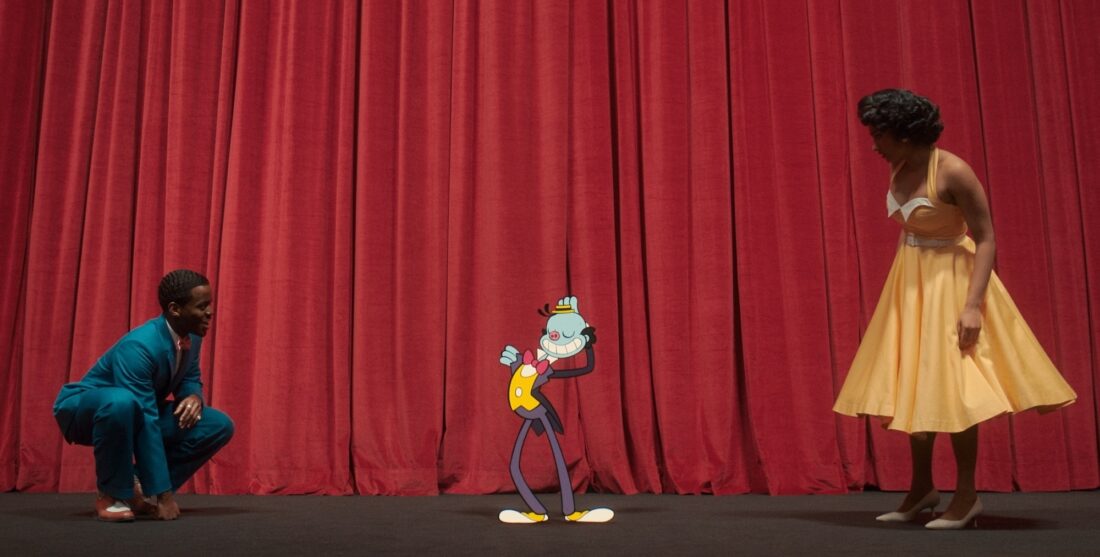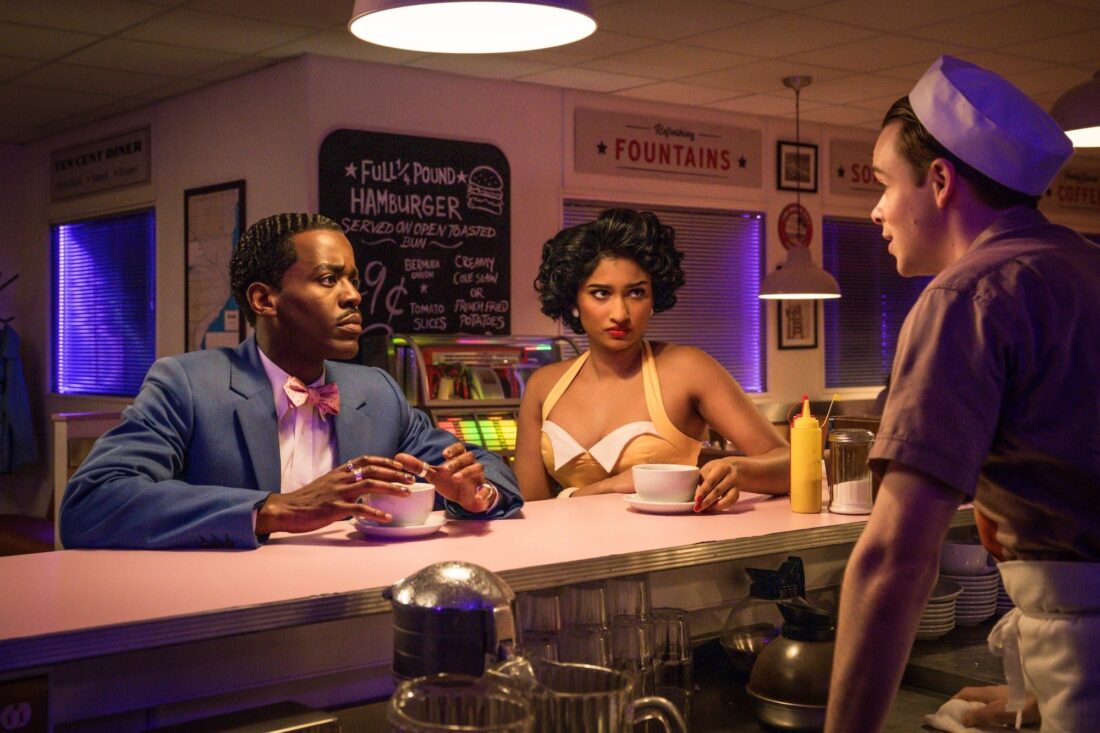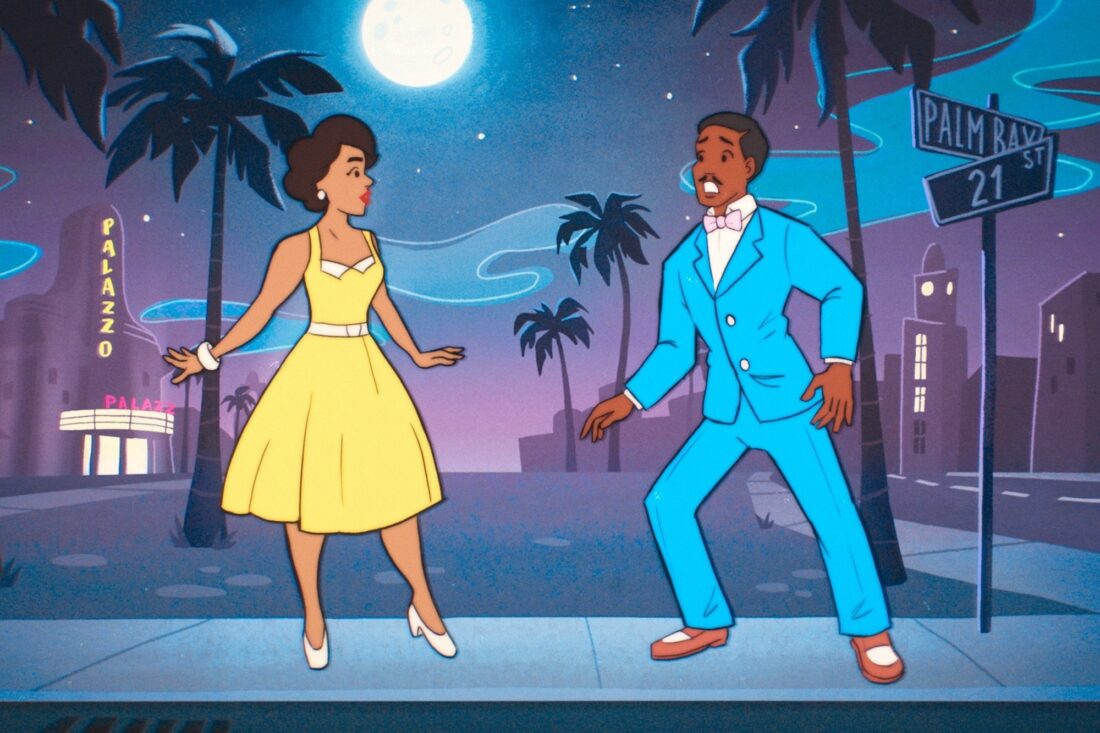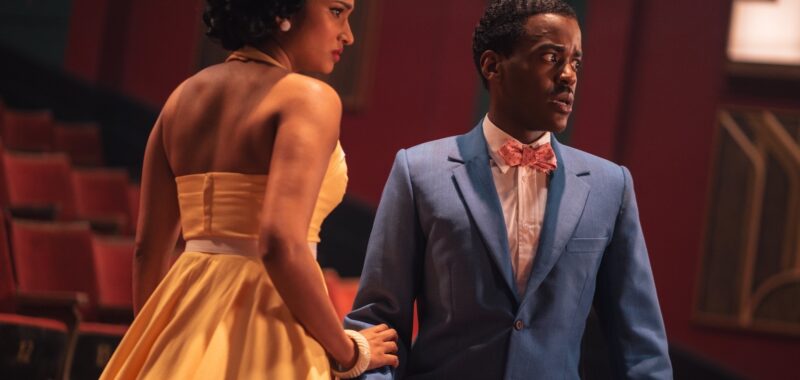We’re back once again with your regularly scheduled reviewer *waves* and an absolute delight of an episode.
Recap

At a cinema in Miami, Florida in the year 1952, a group of viewers are watching news reels about the atomic bomb. Next up is a cartoon about Mr. Ring-a-Ding (Alan Cumming, back again after his turn as James I in “The Witchfinders”) that contains a very catchy little tune. While it plays, moonlight bounces off a spoon in the projector room and onto the screen, which somehow brings Mr. Ring-a-Ding to life, and he comes through the screen to greet the audience as they scream.
Back on the TARDIS, the Doctor tells Belinda that he’s got a plan to get her home to May 24, 2025. It involves landing and using a contraption called a Vortex Indicator, which will act as an anchor that draws them back to the desired date very slowly. They land in 1952, and Belinda notes that her clothes wouldn’t be appropriate for the past. After the Doctor gleefully hauls her off to wardrobe, they both reemerge in stunning period-accurate getups complete with hair and makeup. It’s the middle of the night in; they have landed next to a movie theater that has been chained shut. There are flowers and notes on the doorstep, mourning multiple people. The Vortex Indicator does its job and Belinda wants to be off, but realizes the Doctor wants to investigate. They head to a diner across the road, where the server (Lewis Cornay) tells them all about the 15 people who disappeared from that theater three months ago. The police searched it up and down, finding nothing. There’s films still playing at night because the projectionist, Reginald Pye (Linus Roache) keeps them going, despite the place being locked up.
They’re introduced to Renée Lowenstein (Lucy Thackeray), who is happy to let them sit with her and ask questions if the diner doesn’t mind bending the rules; 1952 Florida is a legally segregated place, and “blacks” (which would include Belinda, regardless of specific ethnicity) aren’t allowed to sit. The server doesn’t mind, as it’s the middle of the night and no one is there to complain. Renée tells them about her boy who disappeared that night in the theater, and how she comes there often, unwilling to give up her search. The Doctor tells her to hold onto her hope, as it’s the most powerful thing she has. He promises to find her son. Inside the theater, the Doctor arrives on the stage and calls up to Mr. Pye, who is silently begging them to leave. They are met by Mr. Ring-a-Ding, who seems to be a living cartoon, a being made of light.
For every question, Mr. Ring-a-Ding tells the Doctor not to make him laugh (his cartoon catchphrase), until the Doctor finally asks why. The reason is because his laugh is “The Giggle,” indicative of the Toymaker’s children. Mr. Ring-a-Ding is truly Lux Imperator, the god of light, who is one of the Gods of Chaos. Before he can descend on them, the projector begins to play and traps Lux into the Mr. Ring-a-Ding dance number. The Doctor and Belinda flee to the projector room to talk to Reginald Pye, who admits that the reason he’s been playing movies is to feed Lux light, in exchange for the chance to see his dead wife as a resurrected image. The Doctor finds the 15 missing people, imprinted on cellulose and trapped. Lux finally finds them; the Doctor reminds him that he must admit how he can be beaten, the same rules that apply to the rest of his kind. Lux tells the Doctor to think about what he never does, then turns the Doctor and Belinda into cartoons.
The Doctor and Belinda realize that when they discuss complicated feelings, they become more three-dimensional, until they’re finally fully human again, but still stuck in the film. The Doctor suggests that they try to escape the reel and they find themselves back in the theater—only to be set upon by Renée and a cop (William Meredith), who are there to arrest them for being in a “whites only” space and suspicious activity. The Doctor quickly sees through this ruse: They’re still in the film. Knowing that pulling at the reel doesn’t work, he realizes that perhaps they have to push their way out of the screen. They do, and arrive in the living room of three Doctor Who fans: Robyn (Steph Lacey), Hassan (Samir Arrain), and Lizzie (Bronté Barbé). They tell the Doctor that he’s the main character of a TV show and they are super fans. (Their favorite episode is “Blink,” dismaying the Doctor.)
The group thinks this episode is kind of obvious, but urge the Doctor to get back to the plot and stop Lux, telling him not to worry about them. Belinda is confused by this, but the fans explain: They’re actually the characters in all this, and not even ones important enough to get last names. They thank the Doctor for allowing them to exist in this moment and meet their best friends. The Doctor tells Belinda that they need to halt the film by holding the frame and make it burn under the projector’s heat, which works and pops them back into the real world. The Doctor’s hand is burned, but he’s saved a little extra regenerative energy for this and heals himself. Lux reemerges and ties the Doctor up with film stock; he plans to use the Doctor’s regenerative energy to build himself a body.
The thing Lux never does: Go outside. He wants more light, but he cannot step into it, and hopes that by creating a new body for himself, he can then absorb even more, from something like an atomic explosion. Lux begins to drain the Doctor, becoming hideously three-dimensional. Belinda rushes to burn the film stock and the cinema with it. Mr. Pye is the one with matches, but he’s too afraid, until the image of his wife (Jane Hancock) comes to him with matches in hand and tells him to do this in order to find her again. Pye tells Belinda to flee and burns the stock himself. An explosion from the fire puts a hole in the wall of the building and daylight hits Lux, who reverts to two dimensions and grows and grows in the sunlight until he’s ever-expanding and everywhere and dissipates into nothingness. The missing people are returned to the world and reunited with their loved ones. As the Doctor and Belinda leave, Mrs. Flood shows up and encourages everyone to watch the TARDIS’s departure, saying it’s a great show—one that will be ending on May 24th. And that’s a wrap.
Suddenly there’s a mid-credits scene where the trio of fans begin criticizing the episode… only to realize, with joy, that they are still here.
Commentary

Okay, there are layers to this one.
This episode is steeped in metafiction, but in the best possible way—with a wink and a nudge, rather than the insistence that everything is so much deeper that way. It’s buzzy and quick and clever, rather than ponderous and tired. And my favorite meta aspect is probably not the most obvious one at first glance…
You see, the Disney-partnered restart of Doctor Who has resulted in labeling all of Fifteen’s episodes as though they’re a new show. Just like the restart of 2005, Gatwa’s era began as another “season one.” (Do I agree with this in practice? No, it’s incredibly confusing. But that’s still how they’re going about it.) So “Lux” is labelled as season two, episode two. In this episode, a being made by moonlight is defeated by destroying it with even more light. When Belinda questions this, the Doctor tells her, “We’re 60 percent water and we can still drown.”
Any of that sound familiar?
Oh right, “Tooth and Claw,” a delightful adventure in Scotland with the Tenth Doctor and Rose Tyler. Where the antagonist was a werewolf—made by moonlight. And the creature is defeated with an abundance of focused moonlight. And when Rose questions this, the Doctor tells her, “You’re 70 percent water—you can still drown.”
In season two, episode two.
I may have punched the air when that came to me.
There’s so much to love about this episode. It’s simultaneously expansive and extremely low-rent; obviously the Lux special effects weren’t cheap, but everything else has that old school soundstage feel that sets Doctor Who apart. (Some folks do not like that, but it’s a big winner for me.) All of the animations have clearly been meticulously researched and matched to very specific art styles from different eras. This is technically a first companion adventure (being the first time the companion agrees to join in rather than getting waylaid or kidnapped), and Belinda is jammed through an emotional meat grinder as all the things happen to her at once.
Though I’m sure all viewers will feel differently, I’ve been overall impressed with how Doctor Who is handling racism in Gatwa’s episodes: not shirking the idea out of discomfort, but only allowing it to dominate the narrative when there’s a purpose. Here, we’ve got an acknowledgment of segregation in America at the point when they’ve landed (something Thirteen had to confront more openly due to her companions, but it’s different when it applies to yourself). They’re helped out by a few factors. For one, it’s the dead of night, so there are fewer people to encounter. Helpfully, the white people in the diner across the road aren’t bigots (this coming with the caveat that we don’t know if they’re fighting segregation in any meaningful way aside from not being awful, but hey, every little bit counts). They don’t really get into it, but the fact that they’re from the U.K. helps, too; Americans are largely suckers for those accents in every era, which is the height of irony for obvious reasons.
But Lux’s trick with the police officer was an excellent handling of those themes as well—not just for the continuity joke, but because it metafictionally points out that the way popular fiction addresses racism is often, well, kinda cheap. You feel it when they get stormed in on; the threat has the potential to be real, but it’s also incredibly boring and does nothing to actually help the audience understand how racism affects people. Better for the Doctor to erase it with a smirk here, where it serves no purpose.
Also worth mentioning is that this episode is incredibly low on shooty, explodey action style sequences, and boy do I miss when more television did that. Doctor Who should do that more often than not. This is largely a puzzle episode, with a lot of enjoyable jokes packed in, and it proves how well you can write something that moves and jives without needing all that excessive violence.
This isn’t the first time a show has directly called out its own fandom, but it might be my favorite? Sherlock did it as a send up of all the theorizing fans were doing after the “Reichenbach Fall,” and Supernatural dredged up their own fans more than once, very awkwardly. Superhero yarns will often touch on this conceit through in-universe fans (like Shazam!) or deep fourth wall breaks (She-Hulk). Doctor Who arguably did this with the character of Osgood in a similar vein.
But here, we have a fourth wall break that boomerangs back on itself: The Doctor is being (accurately) told that he’s a fictional character on a television show, only for us to find out that the fans are the fictional characters, created to distract the Doctor from what’s really going on during the episode.
These fans look like many Whovian nerds I’ve met at conventions over the years, unglamorous, bright, and brimming with deep cuts. (The shirts, they’re all more telling than that scarf could ever be.) They feel more real than any version of fandom I’ve ever seen on screen. But… they’re not. And once they come to that realization, they know they’ve got to let the Doctor get back to doing what he does best. But it’s okay. They were born with best friends, and they got to meet them a few minutes ago. That’s a pretty great life, no matter how truncated.
Wasn’t really expecting to cry during this episode, but that’s often how Davies works.
And then they’re not really gone. Because television is magic and the Doctor is magic and there’s no reason not to summon a little more magic after fighting a being made of light and urging him into an existential crisis death that fills the cosmos.
Damn, I love this show.
Time and Space and Sundry

- A very neat little nod to the fan characters saying that they aren’t important enough to get last names—they are listed in the credits with last names. Welcome to Hassan Chowdry, Lizzie Abel and Robyn Gossage. It would be a real treat to see them again, though I’m not sure how they’d manage it.
- All I can think about is how confusing it would be to view a two-dimensional being in a three-dimensional world? Because it doesn’t seem like Lux is flat, exactly. It’s more like the perspective of him shifts as though he were 3D as you move around him, which I imagine would do such a number on your brain and sense of space. (Also, I love when they render human-ish designed cartoons as 3D beings and we get to see how heinous they’d look in realtime.)
- The palette for this episode was glorious, basically variations on primary colors for the entire wardrobe set. It’s most obvious at the end when the theatergoers come back, but you get the idea well enough with the Doctor’s blue, Belinda’s yellow, and the rich red of the theater itself.
- There is no way you can convince me that the Doctor didn’t do Belinda’s hair. I don’t believe that any other Doctor would have the desire or the patience, but Fifteen absolutely does, and it brings me endless happiness.
- The mention of Rock Hudson feels particularly meaningful for Gatwa’s Doctor—connecting him with queer icons of the past will always wring emotions out of me. Particularly a figure who was officially “outed” for his contraction of HIV, leading to his eventual death from AIDS… the primary reason behind an entire generation of missing queer elders.
- Of course the Doctor is Velma. Most queers are Velma, this is just A Thing That Is Known. This is also not the first time Doctor Who has played with Scooby-Doo references, the most obvious being the chase scene at the start of “Love and Monsters.” The Hanna-Barbera cartoon style was an excellent touch, too.
- Mr. Pye and his wife also made me teary, though the idea that her image is sort of inducing him to suicide is maybe a bit darker than the episode realizes.
- I know that they needed to show the fancy Time Lord energy to seed the idea that Lux would drain him, but it seems incredibly silly for the Doctor to use his all-important leftover regenerative energies to heal a tiny burn.
- Okay, Mrs. Flood, we get it, you’re eternal and everywhere, just tell us who you are already.
See you next week!

